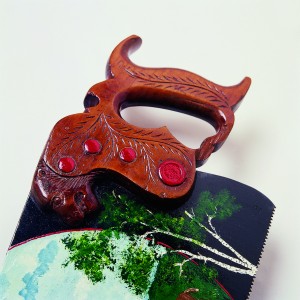We may receive a commission when you use our affiliate links. However, this does not impact our recommendations.
American folk art meets the world’s most collectible hand saw.
by Ralph Brendler
from the June 2004 issue
It’s easy to understand why folk artists love to paint on saws – a saw blade is a large and flat area that is easy to paint, yet the overall shape is instantly recognizable as something “old.” Using an old saw instead of a canvas creates an implicit link with the past.
As a rule, tool collectors (especially collectors of old saws) are not too fond of saw painters. The painting all but ruins the collectible value and usability of the tool, and in most cases the quality of the art is pretty abysmal. However, this isn’t always the case.
At a recent meeting of my local tool collector’s organization, a member brought a painted saw to share that he had recently purchased at a local flea market. It definitely was not a run-of-the-mill example, and it caused quite a stir among the group.
The first thing I noticed was the overall quality of the art. While it’s certainly not a museum piece, it is a big step up from what you often see. There was good balance of the subject, excellent use of color (the sky has some particularly nice brushwork), and the somewhat skewed perspective that is symptomatic of American naïve art. Someone at the meeting pointed out that this work would undoubtedly earn you an “A” at the local community college.
After my quick art appraisal, I examined the saw itself. It looked to be in excellent shape, with the characteristic “nib” that marked it as 19th century production. The handle was in remarkable condition, without the chips, cracks or rodent damage one normally sees on a saw of this vintage.
But the real surprise was the shape of the handle. It didn’t register with me immediately, but I suddenly found myself doing a double take … there was a panther head carved on the handle! This was no ordinary old saw – it was one of the true “holy grails” of saw collecting: the Woodrough and McParlin “Panther” saw!
On Jan. 13, 1880, James R. Woodrough of Cincinnati was issued U.S. Design Patent 11,603 titled simply “Design for Saw-Handles.” The specification is quite short, covering, “A design for handsaw-handles, consisting of the ordinary form of handle, its front end being provided with an ornamental head projecting from said front end over the blade of the saw ….”
This saw was featured in a 1991 Smithsonian magazine article, which stated that only six of these tools were known to exist. Since then more examples have turned up, but it is estimated that there are less than 30 of these left. What’s even more interesting is that this is only the second example that I am aware of that has wheat carving on the handle, making it even more rare.
The combination of rarity and unusual design means these saws are in great demand from collectors, and will command a high price. Even rough examples can sell for $500 or more, and nicer ones will bring $4,000 to $5,000, according to Pete Taran, who runs vintagesaws.com, a site devoted to old saws.
An expert in tool restoration could undoubtedly strip the paint and varnish, and restore the saw to collector condition. If this was done, this saw would likely be the nicest known example of this incredibly rare tool, and could possibly challenge the record auction price for saws. This makes it obvious that the saw should be refinished – or does it? The owner of the saw put it best:
“To me, as a collector, the saw helps celebrate a remembered time when fine hand tools and craftsmanship were an important part of everyday lives. The saw painter celebrates the same bygone era through illustration using an item from the past. Both of us, the collector and the folk artist, are trying to carry forward to tomorrow something from our past. If I were to clean the saw, all I would have when I am done is, well, just another panther saw. Clearly the sum is greater than the parts, so I intend to leave the saw as is.”
After thinking about it for a while, I have to say that I agree with him. After all, what’s more interesting – owning one of 30 known panther saws, or owning the only known painted panther saw? PWM
A longtime collector and researcher of antique tools, Ralph is an avid hand tool woodworker. He oversees the OldTools mailing list online, and is an area director for the Mid-West Tool Collectors Association.
Online Extras
• Mid-West Tool Collectors Association
• OldTools Mailing List
• Vintage Saws
Here are some supplies and tools we find essential in our everyday work around the shop. We may receive a commission from sales referred by our links; however, we have carefully selected these products for their usefulness and quality.










